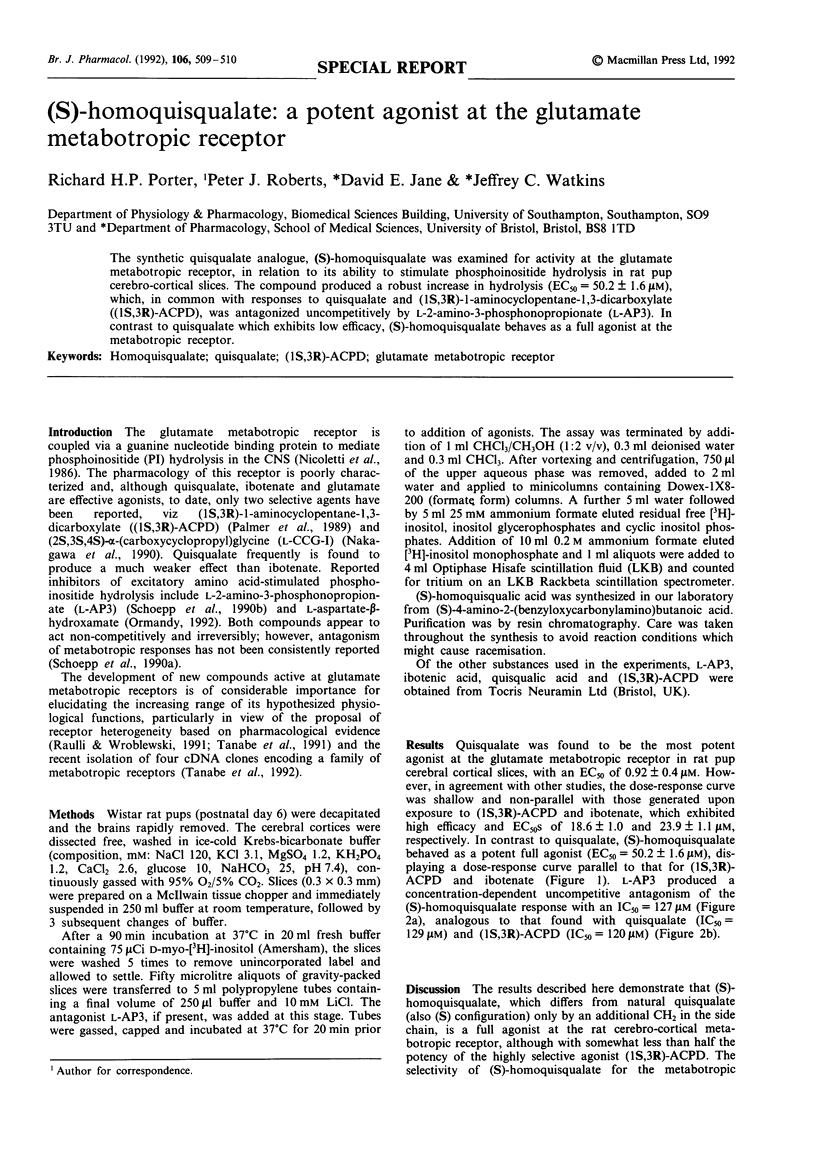Abstract
The synthetic quisqualate analogue, (S)-homoquisqualate was examined for activity at the glutamate metabotropic receptor, in relation to its ability to stimulate phosphoinositide hydrolysis in rat pup cerebro-cortical slices. The compound produced a robust increase in hydrolysis (EC50 = 50.2 +/- 1.6 microM), which, in common with responses to quisqualate and (1S,3R)-1-aminocyclopentane-1,3-dicarboxylate ((1S,3R)-ACPD), was antagonized uncompetitively by L-2-amino-3-phosphonopropionate (L-AP3). In contrast to quisqualate which exhibits low efficacy, (S)-homoquisqualate behaves as a full agonist at the metabotropic receptor.
Full text
PDF

Selected References
These references are in PubMed. This may not be the complete list of references from this article.
- Nakagawa Y., Saitoh K., Ishihara T., Ishida M., Shinozaki H. (2S,3S,4S) alpha-(carboxycyclopropyl)glycine is a novel agonist of metabotropic glutamate receptors. Eur J Pharmacol. 1990 Aug 2;184(1):205–206. doi: 10.1016/0014-2999(90)90686-z. [DOI] [PubMed] [Google Scholar]
- Nicoletti F., Wroblewski J. T., Novelli A., Alho H., Guidotti A., Costa E. The activation of inositol phospholipid metabolism as a signal-transducing system for excitatory amino acids in primary cultures of cerebellar granule cells. J Neurosci. 1986 Jul;6(7):1905–1911. doi: 10.1523/JNEUROSCI.06-07-01905.1986. [DOI] [PMC free article] [PubMed] [Google Scholar]
- Ormandy G. C. Inhibition of excitatory amino acid-stimulated phosphoinositide hydrolysis in rat hippocampus by L-aspartate-beta-hydroxamate. Brain Res. 1992 Feb 14;572(1-2):103–107. doi: 10.1016/0006-8993(92)90457-k. [DOI] [PubMed] [Google Scholar]
- Palmer E., Monaghan D. T., Cotman C. W. Trans-ACPD, a selective agonist of the phosphoinositide-coupled excitatory amino acid receptor. Eur J Pharmacol. 1989 Aug 3;166(3):585–587. doi: 10.1016/0014-2999(89)90383-x. [DOI] [PubMed] [Google Scholar]
- Schoepp D. D., Johnson B. G., Smith E. C., McQuaid L. A. Stereoselectivity and mode of inhibition of phosphoinositide-coupled excitatory amino acid receptors by 2-amino-3-phosphonopropionic acid. Mol Pharmacol. 1990 Aug;38(2):222–228. [PubMed] [Google Scholar]
- Schoepp D., Bockaert J., Sladeczek F. Pharmacological and functional characteristics of metabotropic excitatory amino acid receptors. Trends Pharmacol Sci. 1990 Dec;11(12):508–515. doi: 10.1016/0165-6147(90)90052-a. [DOI] [PubMed] [Google Scholar]
- Tanabe S., Ito I., Sugiyama H. Possible heterogeneity of metabotropic glutamate receptors induced in Xenopus oocytes by rat brain mRNA. Neurosci Res. 1991 Feb;10(1):71–77. doi: 10.1016/0168-0102(91)90021-p. [DOI] [PubMed] [Google Scholar]
- Tanabe Y., Masu M., Ishii T., Shigemoto R., Nakanishi S. A family of metabotropic glutamate receptors. Neuron. 1992 Jan;8(1):169–179. doi: 10.1016/0896-6273(92)90118-w. [DOI] [PubMed] [Google Scholar]


